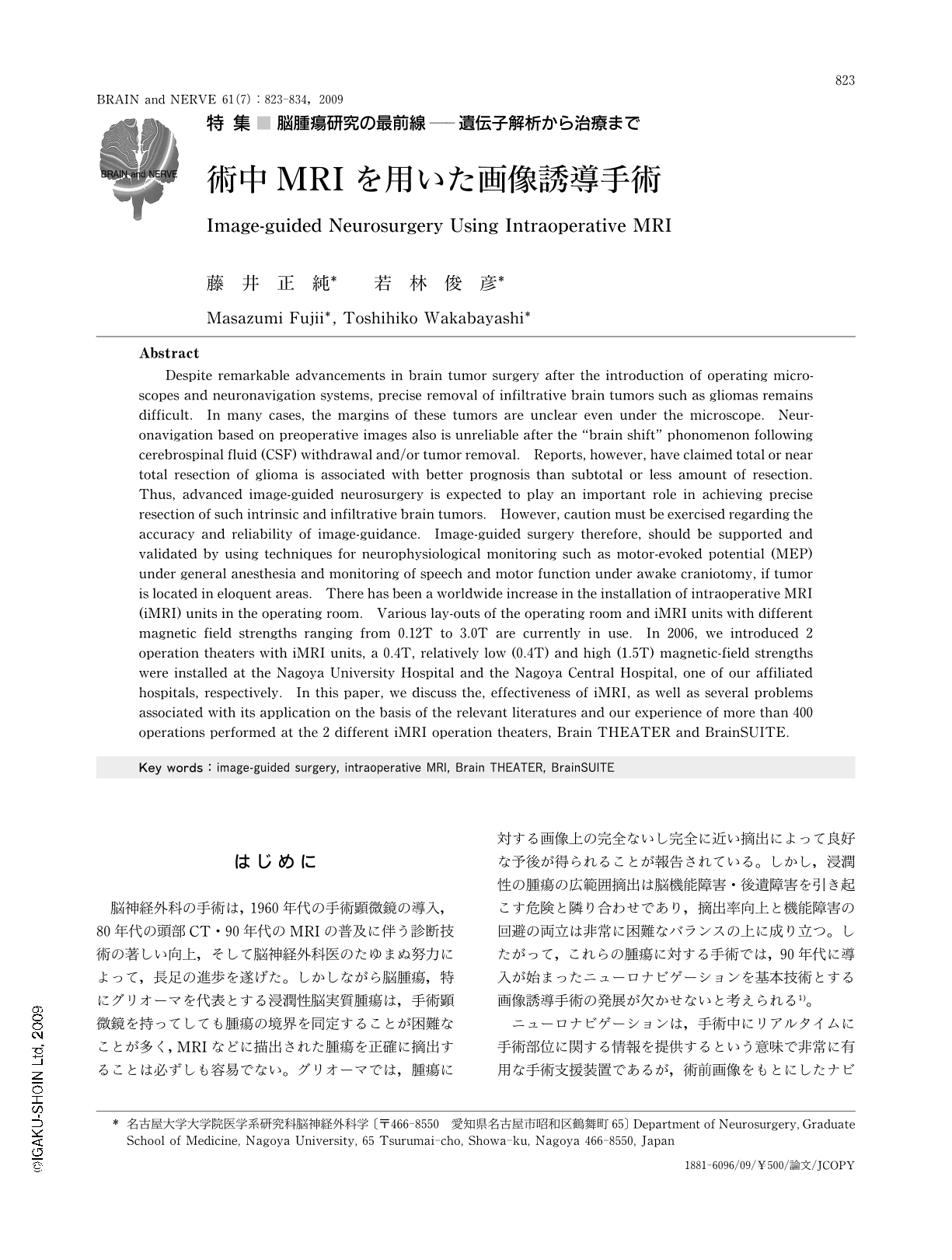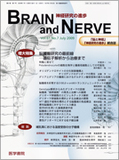Japanese
English
- 有料閲覧
- Abstract 文献概要
- 1ページ目 Look Inside
- 参考文献 Reference
はじめに
脳神経外科の手術は,1960年代の手術顕微鏡の導入,80年代の頭部CT・90年代のMRIの普及に伴う診断技術の著しい向上,そして脳神経外科医のたゆまぬ努力によって,長足の進歩を遂げた。しかしながら脳腫瘍,特にグリオーマを代表とする浸潤性脳実質腫瘍は,手術顕微鏡を持ってしても腫瘍の境界を同定することが困難なことが多く,MRIなどに描出された腫瘍を正確に摘出することは必ずしも容易でない。グリオーマでは,腫瘍に対する画像上の完全ないし完全に近い摘出によって良好な予後が得られることが報告されている。しかし,浸潤性の腫瘍の広範囲摘出は脳機能障害・後遺障害を引き起こす危険と隣り合わせであり,摘出率向上と機能障害の回避の両立は非常に困難なバランスの上に成り立つ。したがって,これらの腫瘍に対する手術では,90年代に導入が始まったニューロナビゲーションを基本技術とする画像誘導手術の発展が欠かせないと考えられる1)。
ニューロナビゲーションは,手術中にリアルタイムに手術部位に関する情報を提供するという意味で非常に有用な手術支援装置であるが,術前画像をもとにしたナビゲーションでは,術中の脳変形すなわちブレインシフトによる著しい精度低下の問題が存在する。手術の進行に伴って,脳表が開頭縁より20mm近く落ち込むような変形も稀ならず経験する。こうした術中の脳変形は,術前画像を地図とするナビゲーションの信頼性を著しく損なうため,ブレインシフトに対する適切な対応が急務である。これに対して,フェンスポスト法,すなわち開頭後ブレインシフトが起こる前に境界領域に“杭”を数箇所打ってブレインシフトに備える方法など,ブレインシフトの影響をなんとか軽減するような努力が試みられているが2),ダイナミックに変形する脳や3次元的に広がりを持つ病変と対峙し,正確な画像誘導手術を行うためには,術中MRIによる術中診断とニューロナビゲーション情報の更新に及ばないと考えられる。
一方,脳診断画像の進歩によって現在利用できる画像としてさまざまなものが登場し,術前診断,手術戦略立案,術中支援に役立つ。MRI像については,これまで標準的であったT1強調像,T2強調像,FLAIR画像のほかに拡散強調画像,ADC(apparent diffusion coefficient)map,DTI(diffusion tensor imaging),T2*,MR spectroscopy,functional MRI,MR angiographyなどが既に臨床応用されている。また,FDG-PETに代表されるPET検査,SPECT検査などの核医学検査,脳磁図が利用可能である。さらに,X線CT検査も最近ではmultislice・helical CTの普及がある。これらの多様な画像を術中支援として用いることは,より適切な脳神経外科手術を実現するうえで,大きなアドバンテージとなると考えられる。さらに,コンピューター工学の進歩によって,進んだ3D技術,画像解析技術の利用が可能である3)。
画像上の進歩は目覚ましいものがあるが,いまだ脳機能画像の信頼性は完全と言えないため,安全な手術を行うためには,SEP(smatosensory evoked potential),MEP(motor evoked potential),ABR(auditory brainstem response)などの生理学的なモニター,言語野近傍腫瘍などにおいては覚醒下開頭術などの術中脳機能モニターを併用することもまた,重要と考えられる3)。腫瘍の切除を考えた場合,こうした画像情報・組織情報および機能情報などを総合して,最大限の切除と安全の確保を両立させることが,今後の脳神経外科手術において重要なものになると考えられる4,5)(Fig.1,2)。
Abstract
Despite remarkable advancements in brain tumor surgery after the introduction of operating microscopes and neuronavigation systems,precise removal of infiltrative brain tumors such as gliomas remains difficult. In many cases,the margins of these tumors are unclear even under the microscope. Neuronavigation based on preoperative images also is unreliable after the "brain shift" phonomenon following cerebrospinal fluid (CSF) withdrawal and/or tumor removal. Reports,however,have claimed total or near total resection of glioma is associated with better prognosis than subtotal or less amount of resection. Thus,advanced image-guided neurosurgery is expected to play an important role in achieving precise resection of such intrinsic and infiltrative brain tumors. However,caution must be exercised regarding the accuracy and reliability of image-guidance. Image-guided surgery therefore,should be supported and validated by using techniques for neurophysiological monitoring such as motor-evoked potential (MEP) under general anesthesia and monitoring of speech and motor function under awake craniotomy,if tumor is located in eloquent areas. There has been a worldwide increase in the installation of intraoperative MRI (iMRI) units in the operating room. Various lay-outs of the operating room and iMRI units with different magnetic field strengths ranging from 0.12T to 3.0T are currently in use. In 2006,we introduced 2 operation theaters with iMRI units,a 0.4T,relatively low (0.4T) and high (1.5T) magnetic-field strengths were installed at the Nagoya University Hospital and the Nagoya Central Hospital,one of our affiliated hospitals,respectively. In this paper,we discuss the,effectiveness of iMRI,as well as several problems associated with its application on the basis of the relevant literatures and our experience of more than 400 operations performed at the 2 different iMRI operation theaters,Brain THEATER and BrainSUITE.

Copyright © 2009, Igaku-Shoin Ltd. All rights reserved.


